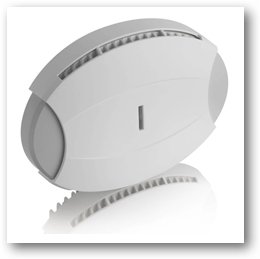GSM pico cell's moment of fame
March 2007
 Back in May 2006, the
DECT - GSM guard bands, 1781.7-1785 MHz and 1876.7-1880 MHz, originally set up to protect cordless phones from interference by GSM mobiles were made available to a
number of licensees. As is the fashion, these allocations were offered to industry by holding an auction with a reserve price of �50,000 per license. In fact, it was Ofcom's first auction
and I guess they were happy with the results although I would not have liked to have been in charge of Colt's bidding team when it came to report to their Board post the auction!
Back in May 2006, the
DECT - GSM guard bands, 1781.7-1785 MHz and 1876.7-1880 MHz, originally set up to protect cordless phones from interference by GSM mobiles were made available to a
number of licensees. As is the fashion, these allocations were offered to industry by holding an auction with a reserve price of �50,000 per license. In fact, it was Ofcom's first auction
and I guess they were happy with the results although I would not have liked to have been in charge of Colt's bidding team when it came to report to their Board post the auction!
For those of a technical bent, you can see Ofcom's technical study here in a document entitled Interference scenarios, coordination between licensees and power limits and there is a good overview of cellular networks on Wikipedia also
The most important restriction on the use of this spectrum was outlined by the study:
This analysis confirms that a low power system based on GSM pico cells operating at the 23dBm power (200mW) level can provide coverage in an example multi-storey office scenario. Two pico cells per floor would meet the coverage requirements in the example 50m � 120m office building. For a population of 300 people per floor, the two pico cells would also meet the traffic demand.
It was all done using sealed bids so there was inevitably a wide spectrum (sorry for the pun!) of responses ranging from just over �50,000 to the highest, Colt, who bid �1,513,218. The 12 companies winning licenses were:
|
British Telecommunications |
�275,112 |
|
Cable & Wireless |
�51,002 |
|
COLT Mobile Telecommunications |
�1,513,218 |
|
Cyberpress Ltd |
�151,999 |
|
FMS Solutions Ltd |
�113,000 |
|
Mapesbury Communications |
�76,660 |
|
O2 |
�209,888 |
|
Opal Telecom |
�155,555 |
|
PLDT |
�88,889 |
|
Shyam Telecom UK |
�101,011 |
|
Spring Mobil |
�50,110 |
|
Teleware |
�1,001,880 |

 One
company that focuses on the supply of GSM and 3G picocells is IP Access based in Cambridge. Their nanoBTS base station can be deployed
in buildings, shopping centres, transport terminals, at home, underground stations, rural and remote deployments; in fact, almost anywhere - according to their web site.
One
company that focuses on the supply of GSM and 3G picocells is IP Access based in Cambridge. Their nanoBTS base station can be deployed
in buildings, shopping centres, transport terminals, at home, underground stations, rural and remote deployments; in fact, almost anywhere - according to their web site.
Many of the bigger suppliers of GSM and 3G equipment manufacture pico cell platforms as well, Nortel for example.
Of course, even though the pico cell base station (BTS) is lower cost compared to standard base stations, that is not the end to the costs. A pico cell operator still needs to install a base station controller (BSC) which can control a number of base stations plus an home location register (HLR) which stores the current state of mobile phone in a database database. If the network needs to support roaming customers, a virtual location register (VLR) is also required. On top of this, interconnect equipment to other mobile operators is required. All this does not come cheap!
Pico GSM cells are low power versions of their big brothers and are usually associated with a lower-cost backhaul technology based on IP in place of traditional point to point microwave links. GSM Pico cell technology can be used in a number of application scenarios.
In-building use as the basis of 'seamless' fixed-mobile voice services. The use of mobile phones as a replacement to fixed telephones has always been a key ambition for mobile operators. But, as we all know, in-building coverage by cellular operators is often not too good leading to the necessity of taking calls near windows or on balconies. The installation of an in-building pico-cell is one way of providing this coverage and comes under the heading of fixed mobile integration. One challenge in this scenario is the possible need to manually swap SIM cards when entering or exiting the building if a different operator is used inside the building to that outside. Of course, nobody would be willing to do this physically so a whole industry has been born to support dual SIM cards which can be selected from a menu option.
From a usability and interoperability perspectives fixed-mobile integration still represents a major industry challenge. Not the least of the problems is that a swap from one operator to another could trigger roaming charges. This is probably an application area that only the bigger license winners will participate in.
On ships using satellite backhaul: This has always been an obvious application for pico cells, especially for cruise ships.
On aeroplanes: In-cabin use of mobile phones is much more contentious than use on ships and I could write a complete post on this particular subject! But, I guess this is inevitable no matter how irritating it would be to fellow passengers - no bias here! e.g. OnAir with their agreement with Airbus.
 Overseas network extensions:
I was interested in finding out how some of the winners of the OFCOM auction were getting on now that they held some prime spectrum in the UK so I talked with Magnus Kelly, MD at
Mapesbury (MCom). I'm sure they were happy with what they paid as they were at the 'right end' of the price spectrum.
Overseas network extensions:
I was interested in finding out how some of the winners of the OFCOM auction were getting on now that they held some prime spectrum in the UK so I talked with Magnus Kelly, MD at
Mapesbury (MCom). I'm sure they were happy with what they paid as they were at the 'right end' of the price spectrum.
Mapesbury are a relatively small service provider set up in 2002 to offer data, voice and wireless connectivity services to local communities. In 2003, MCom acquired the assets of Forecourt Television Limited, also known as FTV. FTV had a network of advertising screens on a selection of petrol station forecourts, among them Texaco. This was when I first met Magnus. Using this infrastructure, they later signed a contract with T-Mobile UK, to offer a W-Fi service in selected Texaco service stations across the UK.
More recently, they opened their first IP.District, providing complete Wi-Fi coverage over Watford, Herts using 5.8GHz spectrum. MCom has had pilot users testing the service for the last 12 months.
Magnus was quite ebullient about how things were going on the pico-cell front although there were a few sighs when talking about organising and negotiating the allocation of the required number blocks and point codes necessitated by the trials that they have been running.
He emphasised that that the technology seemed to work well and the issues they now had were the same as any company in the circumstances; creating a business that made money. They have looked at a number of applications and decided that the fixed-mobile integration is probably best left to the major mobile operators.
They are enamoured by the opportunities presented by what is called Overseas network extensions. In essence, this is creating what can envisioned as 'bubble' extensions to non-UK mobile networks in the UK. The traffic generated in these extensions can then be backhauled using low cost IP pipes. The core value proposition is low-cost mobile telephone calls aimed at dense local clusters of people using mobile phones. For example, these could be clusters of UK immigrants who would like the ability to make low-cost calls from their mobile phones back to their home countries. Clearly in these circumstances, these pico-cell GSM bubbles would be focused on selected city suburbs as they are following the same subscriber density logic that drives Wi-Fi cell deployment.

In the large mobile operator camp, O2 announced in November 2006 that they will offer indoor, low-power GSM base stations connected via broadband as part of its fixed-mobile convergence (FMC) strategy, an approach that will let customers use standard mobile phones in the office. I'll be writing a post about FMC in the future.
Although it is early days for GSM pico cell deployment in the UK, it looks like it could have have a healthy future, although this should not be taken for granted. There are a host of technical, commercial and regulatory and political challenges to seamless use of phones inside and outside of buildings. There are also other technology solutions - IT based rather than wireless - for reducing mobile phone bills. An example of such an innovative approach is supplied by OnRelay.
